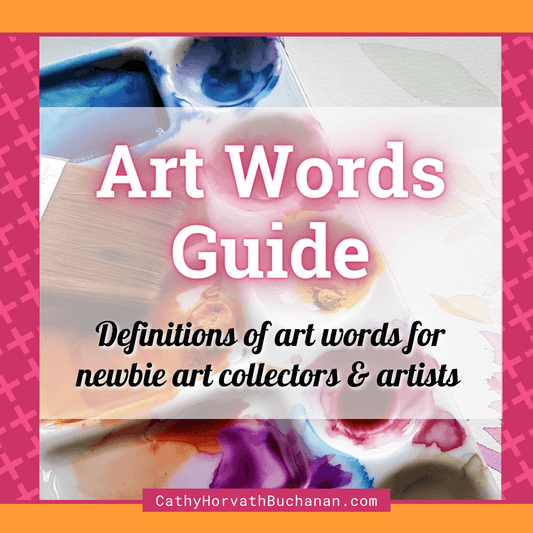
Understanding 'Art Speak'...
A quick intro guide to the definition of art specific words for art buyers and new artists.
If you’re thinking you’d love to buy some art to brighten the walls of your home, but feel like you don’t understand what you may or may not be purchasing based on the terms describing the artwork…or maybe you’re a newbie artist and just want to know some key terms so you know what to ask for at the art store… then don’t worry I've got you covered.
This blog post includes a list of terms that are often used by artists to describe their art, materials and style, in the creation of works of art such as paintings and prints. Sometimes this specialized language can be off-putting for those who are unfamiliar with the arts. This guide will help you know some of the words, so you can speak the ‘art speak’ too.
Below are some very basic definitions that will help you understand the nuts and bolts of the most popular words used in art and art making methods

Paint and mediums...
The following materials provide artists with options for expressing themselves, each medium with its own unique characteristics and uses.
Medium: The materials used by an artist to create their work. Mediums can include oil paint, watercolor, charcoal, clay, digital software, and more. The choice of medium often influences the texture, depth, and overall aesthetic of the artwork.
Acrylic Paint: A relatively new type of paint invented in the 1940’s. This quick-drying paint can be thinned with water, and is made of colors mixed with a type of plastic resin. It works on many surfaces and is very durable when dry.
Oil Paint: A widely used slow-drying paint made by mixing colors with oil. It's known for blending well and creating rich colors. This is most often the type of paint used in famous masterpieces throughout history.
Egg tempera: A traditional painting medium known for its smooth texture and vibrant colors. Artists use egg tempera paint by mixing the pigments with egg yolk and water to create a rich, opaque paint that dries quickly and creates detailed, finely textured artwork. It has been used for centuries in religious icons, illuminated manuscripts, etc..
Watercolors: Paint made of colors that are mixed with water to achieve depth through transparent layering and used on special paper. It can be damaged by humidity and reactivated with water
Gouache: Opaque watercolor paint mixed with chalk. It dries quickly leaving a flat sheen of solid colors. The same as watercolor it can be reactivated with water.
Pastels: Colorful sticks made of pigment and binder. They're like crayons and can be blended on paper. Art made from pastels can be delicate and susceptible to smearing
Collage Mixed Media: Art made by gluing different materials like paper, fabric, and found objects onto a surface.
Graphite Pencil: A material used in pencils for drawing and shading. Pencils come in different hardness for light and dark lines.

Paint surfaces...
Substrate: In art making, a substrate is the surface upon which the artwork is created. It's the base layer that provides support for the artistic medium or materials used in the creation process. The substrate may include surfaces like canvas, paper, wood, fabric, metal, or even walls.
Gesso: A primer (usually white) used to prepare surfaces like canvas for painting. It makes the surface smoother and helps paint stick better.
Unstretched Canvas: Canvas fabric that isn't stretched over a frame yet. It can be cut to size and mounted later.
Stretched Canvas: Canvas fabric stretched over a wooden frame. It's ready for painting and comes in various sizes.
Gallery Stretched Canvas: Stretched canvas that has a profile of 1.5" (vs .75" for standard) and is wrapped around the wood stretcher bars and stapled on the back.
Canvas Board: Canvas fabric glued to a stiff board. It's portable and used for painting sketches.
Canvas Paper: Textured paper that looks like canvas. It's good for practicing painting techniques.
Watercolor Paper: Paper specifically for use with watercolor paints. The unique texture and thickness absorbs water and paint without warping or tearing and comes in various weights and textures, such as rough, cold-pressed, and hot-pressed
Wood Panel: A flat piece of wood or MDF particle board used as a surface for painting. It's sturdy and can be prepared like canvas.
Cradled Birch Panel: A wooden plywood panel with birch veneer. Cradled with a support on the back for extra strength and to prevent warping.
Archival materials: Where the quality of the materials (ink, paint, paper, canvas etc.) used in the creation of the art or print hold their form, color and value for a very long time, hopefully centuries.
Acid free: Materials (usually paper, canvas, framing mats) that have a PH of 7 or above. Acid degrades paper over time and will result in deterioration due to light and air so any artworks created using acidic materials have a shorter life span.
The hand of the artist...
These following are terms to describe the level of the artist’s hand in the creation of the artwork (ie, one-of-a-kind vs, multiples).
Original Artwork: An original artwork is a piece created directly by the artist's hand. It's unique and one-of-a-kind,
Art Print Reproduction: An art print reproduction is a copy of an original artwork made through printing techniques like lithography or digital printing. It allows the artwork to be reproduced and distributed to a wider audience.
Limited Edition Art Print: A limited edition art print is a reproduction of an original artwork that's produced in a limited quantity. Each print is numbered and signed by the artist, ensuring its authenticity and value.
Giclee Print: A giclee print is a high-quality reproduction of an original artwork created using inkjet printing technology. It's known for its archival quality and ability to capture fine details and vibrant colors.
Original Print: An original print is an artwork created through printmaking techniques such as mono-print, etching, lithography, linocut woodcut, or screen printing. While it's a reproduction in the sense that multiple prints can be made, each print is considered an original because it's created by the artist's hand and involves unique processes. Each print will have slight variations within the series that makes them unique.

Depicting subjects...
The following are explanations of the types of subjects an artist would convey through a work of art.
Subject Matter: Subject matter in art refers to what the artwork is about or what it portrays. It's the main theme, topic, or idea that the artist explores and communicates through their work. Subject matter can vary widely and may include people, landscapes, objects, emotions, or abstract concepts.
Point of Departure: ‘Point of departure’ in art refers to the starting point or initial idea that inspires an artist's work. It's the first step or the beginning of a journey. Artists often use a point of departure to explore themes, emotions, or concepts that they want to convey in their art. It's where the creative process begins, and from there, artists develop their ideas and bring them to life through their chosen medium.
Motif: A motif in art is a recurring theme, symbol, or design element that appears throughout an artwork or a series of artworks. It can be a specific shape, pattern, color, or object that holds symbolic or aesthetic significance and helps to unify the composition or convey a particular message or mood.
Still Life: Still life is a genre of art that focuses on depicting inanimate objects, such as flowers, fruit, food, and everyday items, arranged in a composed and deliberate manner. Artists often use still life compositions to explore concepts of beauty, symbolism, and the passage of time, and to experiment with light, color, and texture.
Life Drawing: Life drawing is the practice of drawing or sketching from a live model, typically depicting the human figure. It's an essential exercise for artists to study anatomy, proportion, gesture, and expression. Life drawing sessions provide artists with the opportunity to observe and capture the complexities and nuances of the human form in various poses and contexts.
Figurative: Figurative art is artwork that represents recognizable figures or objects from the real world. It can include depictions of people, animals, landscapes, and objects, rendered in a representational or realistic style. Figurative art allows artists to explore themes of identity, emotion, narrative, and social commentary through the portrayal of familiar subjects.
Landscape: A landscape is a subject matter in art that focuses on depicting scenes from nature, such as mountains, forests, rivers, fields, and skies. It often showcases the beauty and vastness of the natural world, capturing elements like light, atmosphere, and the changing seasons. Landscape paintings can evoke feelings of tranquility, awe, and connection to the environment.
Realism: Realism in art is a style or movement characterized by a faithful and accurate depiction of the visual world, often emphasizing detail, clarity, and lifelike representation. Realist artists strive to capture the natural appearance of their subjects with precision and authenticity, conveying a sense of immediacy and truthfulness in their artwork. Realism can encompass various subjects, including portraits, landscapes, still life, and everyday scenes.
Abstraction: Abstraction in art is when the artist simplifies or distorts reality to create a representation that is more about shapes, colors, lines, and forms than it is about depicting recognizable objects or scenes. Instead of painting or drawing things exactly as they appear in the real world, abstract art focuses on conveying emotions, concepts, or impressions in a more symbolic or non-representational way. It allows artists to express themselves freely and encourages viewers to interpret the artwork based on their own perceptions and experiences.

Terms for the art process...
The following terms convey the manner in which an artist expresses themselves through their chosen medium.
Imagery: Visual elements or symbols that convey meaning and evoke sensations within an artwork. Imagery can be representational or abstract, drawing upon familiar motifs or inviting interpretation through metaphor and allegory.
Aesthetics: A branch of philosophy that explores the nature of beauty, art, and taste. Aesthetics delves into questions about perception, interpretation, and the criteria that define what is considered visually pleasing or meaningful.
Composition: The arrangement of visual elements within an artwork, including line, shape, color, texture, and space. Composition guides the viewer's eye and establishes the overall structure and balance of the art piece.
Color Palette: Referring to the range of colors used by an artist in a particular artwork or body of work. The palette can evoke specific moods, convey emotions, or reflect thematic elements.
Form: The physical shape and structure of an object or artwork. Form encompasses both two-dimensional and three-dimensional aspects, capturing the contours, proportions, and spatial relationships within a piece.
Technique: The method or approach employed by an artist to execute their vision. Techniques vary widely across different artistic disciplines and can encompass everything from brushwork and shading and can also refer to the skill with which the work is executed.
Style: A distinctive manner or characteristic mode of expression that defines an artist's work. Style encompasses elements such as brushstroke, line quality, abstraction, and symbolism, reflecting the individuality and creative signature of the artist.
Critique: An analysis or evaluation of an artwork, typically conducted by peers, critics, or instructors. Critiques provide constructive feedback on aspects such as technique, composition, concept, and execution, fostering growth and dialogue within the artistic community.
Conceptual Art: An artistic movement that prioritizes the idea or concept behind the artwork over traditional aesthetic considerations. Conceptual artists often challenge conventional notions of art, exploring themes of identity, politics, and society through thought-provoking concepts and strategies.

There are many more art specific terms that have to do with movements in art and other types of art, but since I am a painter that also sells art prints I kept the definitions within that realm.
If you have questions about these terms, or would like to know definitions for more words, or read blog posts covering other art concepts or ideas please do let me know CONTACT ME







